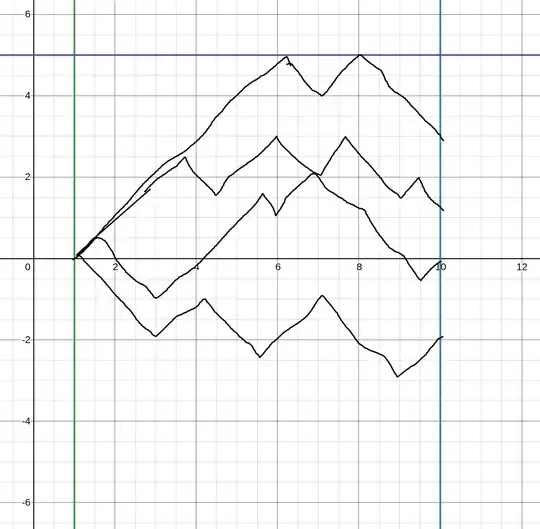Is there a simple proof (without CLT or Markov chains for instance) of the fact that a simple random walk $S_{n}$ will cross any $M>0$ infinitely often? Showing that it leaves any interval $[-M,M]$ is easy, but I am not sure how we could prove the above statement.
2 Answers
How about Gambler's ruin? When restricted to $\{0,1,\ldots,n\}$, the ruin probability starting from 1 is $1-1/n$, so if you take $n \to \infty$, the ruin probability for the walk on $\{0,1,\ldots,\infty\}$ is 1 starting from 1. So you any time you exit $M$ to the left or right, you return with probability 1.
- 1,158
-
How do you derive the ruin probability? Maybe you have a reference or hint... – Claudio Moneo Apr 21 '20 at 17:01
-
1See the below reference for example. It is solved by conditioning and deriving a recursive formula for the ruin probability starting from state $i$. It doesn't require knowledge of CLT or Markov chains. http://www.columbia.edu/~ks20/FE-Notes/4700-07-Notes-GR.pdf – spalein Apr 21 '20 at 17:11
-
Note: Here, you are interested in the $p=q$ case, so the steps become a little simpler. Think about that when you read it. – spalein Apr 21 '20 at 17:13
You are effectively asking to show that for $(S_m)_{m\in\mathbb N}$ where $$S_m=X_1+\dots +X_m$$ and the $(X_m)_{m\in\mathbb N}$ are independent, Rademacher-distributed, we have $$\limsup_{m\to\infty} S_m = \infty$$ almost surely.
Note:
- By the Khinchin-Kolmogoroff law of the iterated logarithm (highly non-trivial), we have $$\limsup_{m\to\infty} \frac{S_m}{\sqrt{2m \ln(\ln(m))}} = 1$$ almost surely, a much stronger statement.
Here is an elementary argument: Let $M\in\mathbb N$. I claim that $$\sup_{m\ge M} S_m=\infty$$ almost surely. Note that it is enough to show that (why?) $$\mathsf P(\sup_{m\ge M} S_m\ge n)=1$$ for all $n\in\mathbb N$. Note that all the paths of $S$ are mountain ranges. So we look at all the mountain ranges (see this post for terminology) from $(M, -M)$ to $\{x+T\}\times\mathbb Z$ that always stay in the lattice $\mathbb Z\times\mathbb Z_{\le n}$ for some fixed $T\in\mathbb N$. There are, if my calculations are good (and if they are not, the idea is still very much the same; see the last application in the post here), $$\sum_{k=-r}^0\binom{T}{\left\lfloor\frac{T+r}2\right\rfloor+k}$$ such mountain ranges where $r=n+M.
From $\log$-convexity of the $\Gamma$-function (see my answer here), we have $$\sum_{k=-r}^0\binom{T}{\left\lfloor\frac{T+r}2\right\rfloor+k}\le (r+1) \frac{\Gamma(T+1)}{\Gamma(1+T/2)^2}.$$
From Stirling's approximation (not used carefully, the attentive reader should check my calculation), the latter term is asymptotically equivalent to $$\frac{\sqrt{2}(r+1)}{\sqrt{\pi T}} 2^T.$$
Now, the probability that $\sup_{m\in\{M,M+1,\dots, M+T\}} S_m \ge n$ is equal to the probability that $S_M\ge n$ or $\dots$ or $S_{M+T}\ge n$, which, since $S_M\ge -M$ almost surely, is at most (exercise: check this) $$2^{-T}\sum_{k=-r}^0\binom{T}{\left\lfloor\frac{T+r}2\right\rfloor+k}$$ where $r=M+n$. But the latter is, as we established, asymptotically at most $$\frac{\sqrt{2}(r+1)}{\sqrt{\pi T}}.$$ This converges to $0$ as $T\to\infty$, and therefore the probability that the limsup is finite is $0$.
Here are some mountain ranges not surpassing a $y$-axis-barrier:
- 13,536
